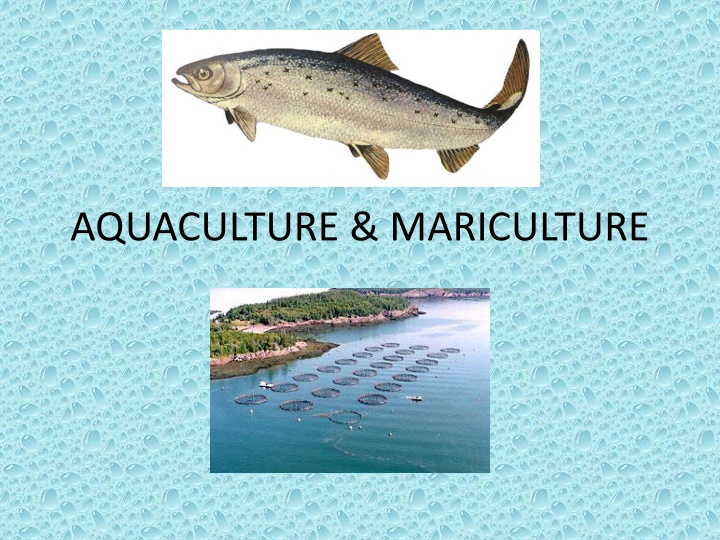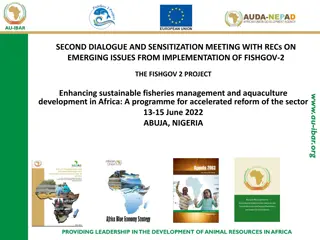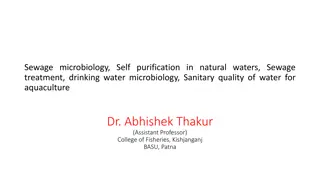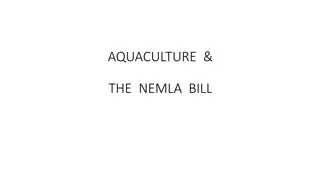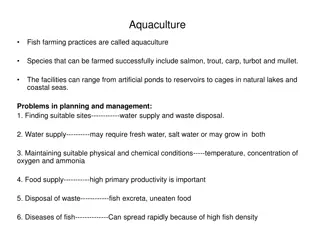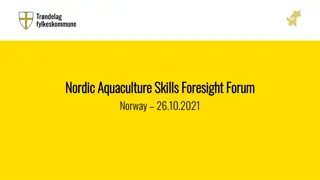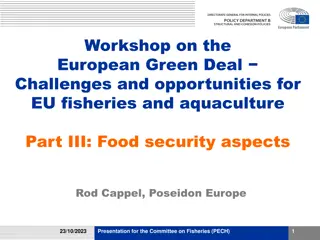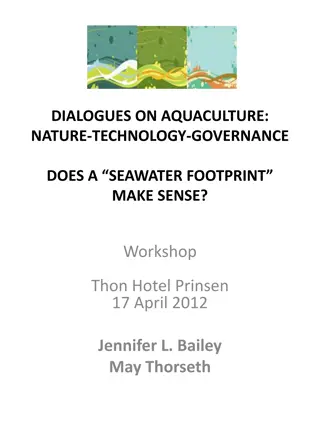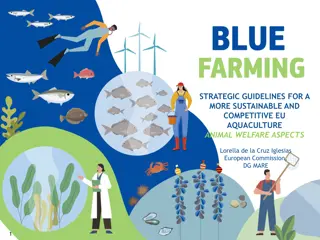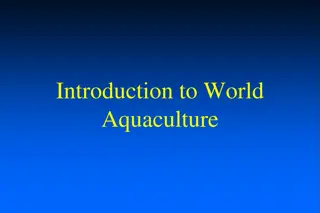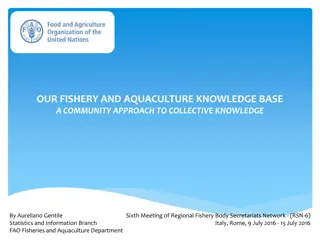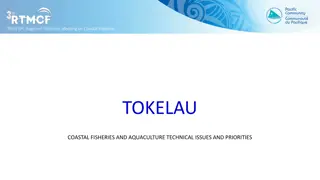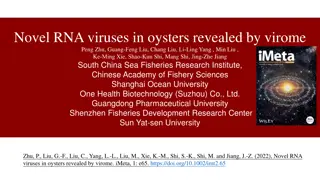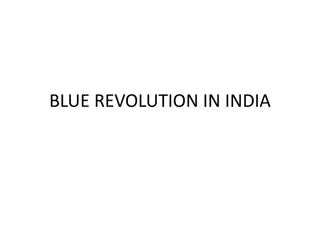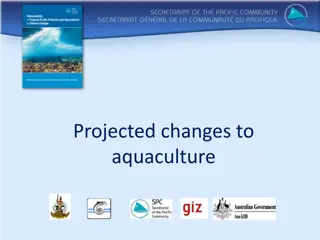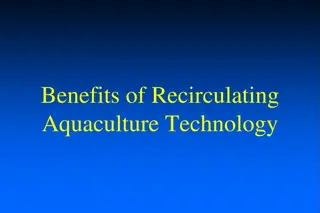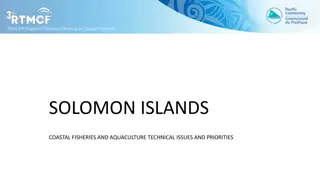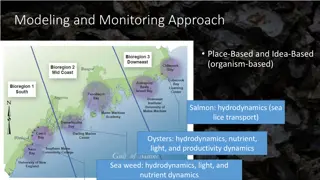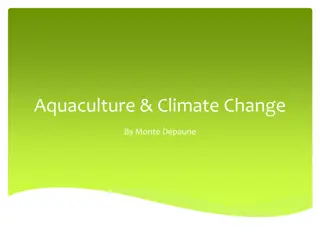Aquaculture and Mariculture Practices
Aquaculture encompasses the breeding, rearing, and harvesting of aquatic organisms in various water environments, while mariculture focuses on marine plants and animals in marine or brackish water. This includes controlled breeding for commercial, recreational, and conservation purposes. Technological advancements like selective breeding and genetic transformation are improving efficiency, but challenges such as negative environmental impacts and the introduction of non-native species need careful consideration for sustainable practices.
Download Presentation

Please find below an Image/Link to download the presentation.
The content on the website is provided AS IS for your information and personal use only. It may not be sold, licensed, or shared on other websites without obtaining consent from the author.If you encounter any issues during the download, it is possible that the publisher has removed the file from their server.
You are allowed to download the files provided on this website for personal or commercial use, subject to the condition that they are used lawfully. All files are the property of their respective owners.
The content on the website is provided AS IS for your information and personal use only. It may not be sold, licensed, or shared on other websites without obtaining consent from the author.
E N D
Presentation Transcript
AQUACULTURE The broad term aquaculture refers to the breeding, rearing, and harvesting of plants and animals in all types of water environments, including ponds, rivers, lakes, and the ocean. The breeding & rearing of fish, shellfish, or plants in ponds, enclosures, or other forms of confinement in fresh/marine waters for direct harvest of the product.
The propagation and rearing of aquatic organisms (both marine and freshwater) in controlled or selected aquatic environments for any commercial, recreational, or public purpose . Potential purposes of aquaculture include bait production, wild stock enhancement, fish cultures for zoos and aquaria, rebuilding of populations of threatened and endangered species, and food production for human consumption" (NOAA Aquaculture Policy, 1998).
NEGATIVE IMPACTS OF AQUACULTURE ON THE ENVIRONMENT Find out 4/5 negative impacts How they are mitigated against/avoided or controlled.
TECHNOLOGICAL PROGRESS IN AQUACULTURE Selective breeding approaches have been successful at creating improved breeds of fish (e.g. salmon, tilapia & carp) which increase yield & overall efficiency of intensive & extensive aquaculture production. Genetic transformation technologies may also be useful in the future for breed improvement. However, care must be taken in the use & release of GM fish because of competition effects & ease of mixing w/ wild stocks in aquatic environments.
One way to avoid this is by producing sterile individuals which can t reproduce. Advances in hatchery technology have raised the possibility of replenishing wild fisheries (restocking) from such sources. Unfortunately, much of research into stocking marine spp. is still in experimental stage. Restocking w/ alien spp. can have disastrous on local biodiversity & need to be avoided from an environmental standpoint. Example of disaster intro of non-native species (Nile perch) in Lake Victoria
MARICULTURE The farming & husbandry of marine plants & animals in brackish water/marine environments. Output is growing globally, & its practices have important implications for marine & coastal biodiversity on the level of genes, species & ecosystems. Increased from 9M tonnes in 1990 to > 23M tonnes in 1999. Increase is a result of higher production of a few spp. CBD Technical Series 12 Solutions for Sustainable Mariculture Avoiding the Adverse Effects of Mariculture on Biological Diversity 2004.
Provides good quality food More efficient than many other forms of food production farms. Humans consume < 1% of terrestrial 1oorganic matter production (which totals ~ 132B tons, & < 0.02% of the 82 billion tons of 1oproduction of the oceans) Fish can replace terrestrial animals at ~ the level of feed inputs. In other words, 100 kilos of feed can produce 30 kilos of fish or 15 kilos of pork.
Hence, mariculture is a more efficient user of primary productivity than the farming of livestock. Brackish water aquaculture production is dominated y shrimp but also includes finfish & molluscs. Marine aquaculture is dominated by seaweed (Japanese kelp), and molluscs, Pacific cupped oyster and salmon.
Top mariculture species in 2000 Species Annual production (tonnes) Culture environment Top two countries Japanese kelp 4,580,056 M China, Japan Atlantic salmon 883,448 M,B Norway, Chile Whiteleg shrimp 143,737 M,B Ecuador, Mexico Peruvian calico scallop 21,295 M Chile, Peru Japanese flounder/Bastard halibut 21,202 M Rep. of Korea, Japan M marine B - brackish water
METHODS A. For molluscs: i. Vertical/rack culture ii. Hanging culture iii. Bottom culture iv. Land-based tank culture v. Sea ranching B. For crustaceans: i. Pond culture ii. Raceway culture iii. Cage culture iv. Sea ranching
C. For marine aquatic plants i. Suspended culture (longline, raft, net) ii. Bottom culture iii. Tank culture D. For finfish iii. Cage culture (inshore & offshore) iv. Pen culture v. Pond & raceway culture (flow-through & recirculation systems) vi. Sea ranching For each method broodstock, seed supply & growout will be considered as they all have different effects on biodiversity.
Polyculture growing of 2/more species belonging to different trophic levels in the same system. Grouper & mud crab grown in ponds Sea scallops are suspended from salmon net pens Ezo scallop, Japanese kelp & sea cucumber are cultured w/ open water structures like net cages.
MOLLUSC CULTURE Done in tropical & temperate regions depending on species. Oysters, scallops & mussels dominate temperate mariculture while the tropical areas the same species are cultured at a low & local commercial scale.
Broodstock ( ) & seed supply Bivalve mollusc larvae (spat) collected from natural grounds (what effects can this have?) using suitable materials to which larvae adhere or set , or are produced by artificial fertilisation in hatcheries. The latter technique allows much genetic control over the genetic make-up of the stock, as well as transport of larvae to distant grow-out facilities. Parental stock comes from natural environments. Their spawning is induced in captivity. Thus likely that offspring retain genetic diversity of parental stock.
Due to high fecundity of molluscs, only a few organisms are required to sustain seed production. What can this cause? This is a practice which may cause negative effects on genetic diversity of reared population. Studies are being conducted to define the required number of broodstock in order to maintain genetic diversity.
Growout Larvae that have attached/ set to their substrate are grown in: hanging culture (suspended from floating rafts or floating longlines on strings, trays, stacks or mesh bags), vertical or rack culture (sticks or posts are staked on the bottom & act directly as a growing medium or support racks, or platforms) Bottom culture (shells, stones, rocks, cement slabs etc. added to the bottom provide attachment sites) In land-based systems (mostly for sea-ranching) Hanging culture is the most common method of oyster, mussel & scallop culture.
Aquaculture used to restore & replace overfished stocks of molluscs. In overfished stocks, a restoration mgt plan should be adopted to conserve natural genetic diversity as the expansion of mariculture increases the risk on wild popns.
FINFISH Is practiced in both temperate & tropical waters. Examples include catadromous (lives in fresh water and enters salt water to spawn. Most of the eels are catadromous) and marine fish.
Broodstock & seed supply Two main categories of broodstock: domesticated & a mixture tween wild & domesticated. When domesticated broodstock is used concern over conservation of genetic diversity. Less impact is expected on genetic diversity if wild fish are used in combination with domesticated animals. However, it puts pressure on wild stocks by promoting capture of wild organisms.
Most important finfish are grown from larvae or fry produced by controlled reproduction in hatcheries. Collection of fry from natural environment affects recruitment into wild popns by reducing the parental stocks. In the case of Atlantic glass eel, this could lead to collapse of natural reprod ve stocks. In Mediterranean, Asian & L. American countries, seed is still being collected from the wild.
Experiments are under way to produce transgenic fish (genetically modified fish) to enhance performance under growout condition. Special care must be taken to prevent broodstocks from mixing with wild popns. The common practice of transfer of broodstock & fry tween different regions of the globe could have an effect on biodiversity through introduction of allochthonous species (exotic/pertaining to organisms or organic sediments in a given ecosystem that originated in another system. ), diseases & other related impacts.
Growout For most of the major finfish spp., fertilised eggs are incubated until hatching and then conditioned to artificial feed in tanks before transfer to growout facilities (pens, cages, large tanks) Cage culture 2 categories: inshore & offshore cages. Can be either floating, fixed or submerged. Inshore located in protected & usually shallow areas with less water circulation than offshore cages. Offshore cages located in deep water & open areas w/ less protection from storms but with better water exchange.
Cage-reared fish are fed supplemental or artificial diets depending on stocking density & the level of technology applied. In inshore cages, possible impacts include: Water quality degradation Transfer of disease Alteration of benthic community biodiversity Input of antibiotics, antifouling & other chemicals Risk of escapes Impacts can be minimised how? by proper mgt?, site selection? & continuous monitoring
NEGATIVE IMPACTS OF MARICULTURE ON THE ENVIRONMENT Find out 4/5 negative impacts How they are mitigated against/avoided or controlled.
This hatching system consists of a 300 litre rectangular hatching tank and two 120 litre circular tanks, one for collecting larvae and one to house a biofilter http://library.enaca.org/Shrimp/Publications/FAO_Macrobrachium_manual_ 2003.pdf
GLOSSARY Stocking density : Usually an expression of the number of fish per unit area or weight of fish per unit of volume of water at stocking. Stocking (a) Definition(s): Process of moving live organisms to a rearing unit so that ongrowing (e.g. in nursery ponds, fattening ponds) or reproduction (e.g. in spawning ponds) may take place. Stocking (b) Definition(s): The practice of putting artificially reared young fish into a sea, lake or river. These are subsequently caught, preferably at a larger size. Stocking rate Definition(s): The number of fish released per unit of area. word broodstock usually refers only to the females that are kept in hatcheries until their eggs hatch, after which they are discarded or sold. FAO doc on shrimp Supplement Definition(s): A feed used with another to improve the nutritive balance or performance of the total and intended to be: (i) fed undiluted as a supplement to other feeds; or (ii) offered free choice with other parts of the ration separately available; or (iii) further diluted and mixed with other feed ingredients to produce a complete feed.
REFERENCES http://www.unep.org/yearbook/2006/069.asp http://www.crc.uri.edu/index.php?themeid=1 http://www.oceaneconomics.org/LMR/Aquaculture/ http://aquaculture.noaa.gov/what/welcome.html Millenium Ecosystem Assessment. Ecosystems & Human Well being: Current State & Trends, Volume 1 http://www.oceaneconomics.org/LMR/Aquaculture/aquaTerms.asp http://library.enaca.org/Shrimp/Publications/FAO_Macrobrachium_manual_2003.pdf Nice - http://library.enaca.org/Shrimp/Case/Thematic/FinalMangrove.pdf Nice - http://web.archive.org/web/20060206103254/www-mkb.slu.se/mkb/rakodling/Shrimp-webb.pdf http://aquanic.org/species/tilapia/documents/s6.pdf http://www.fao.org/fishery/countrysector/FI-CP_TT/en http://www.fao.org/fishery/countrysector/naso_belize/en ***https://www.was.org/main/summary.asp?page=BasicAquaTech http://www.fao.org/fi/glossary/aquaculture/ http://www.dfo-mpo.gc.ca/aquaculture/ref/aqua-es2009-eng.htm **http://www.aquaculture.org.gy/publications/ETG_Guyana_Action_Plan_Aquaculture__11Dec05_.pdf http://www.fao.org/fishery/countrysector/naso_costarica/en http://www.fao.org/fishery/countrysector/FI-CP_CR/en Negative impacts of aqua - http://www.csa.com/discoveryguides/aquacult/overview.php Note pg 79 of FAO shrimp doc, p. 94, 115, 121, 126 (110), 135
http://www.cdc.gov/ncidod/EID/vol3no4/garrett.htm http://www.fao.org/focus/e/fisheries/aqua.htm http://www.waterencyclopedia.com/A-Bi/Aquaculture.html
